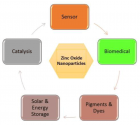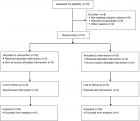Abstract
Review Article
Bio-inspired fabrication of zinc oxide nanoparticles: Insight into biomedical applications
Atta Ullah Khan*, Muhammd Ilyas, Doaa Zamel, Suliman Khan, Abbas Ahmad, Fazeela Kaneez, Sakina Abbas, Syeda Armana Zaidi, Hikmat Ullah, Faisal Adnan, Shehryar Khan, Fazal Rahman and Subhan Ullah Khan
Published: 11 August, 2022 | Volume 6 - Issue 1 | Pages: 023-037
Nanotechnology is starting the characterization, fabrication, and possible applications of numerous materials at the Nano-scale. Over the last few eras, nanomaterials provide a platform for researchers from diverse arenas due to the high surface-to-volume ratio and other novels, and new significant belongings. Zinc oxide nanoparticles are receiving diverse biomedical applications because of their distinctive antimicrobial, antioxidant, anticancer, antifungal, antileishmanial, anti-larvicidal, wound healing, anticholinergic, and anti-diabetic properties. Different physical and chemical approaches have been used to synthesize zinc oxide nanoparticles, but these methods cause ecotoxicity and are time-consuming and costly. Therefore, there is a need for more eco-friendly, cost-effective, and safe methods. Such biogenic Zinc oxide nanoparticles offer more advantages over other physiochemically synthesized methods. In this review, we have summarized the recent literature for the understanding of the green synthesis of Zinc oxide nanoparticles, their characterization, and their various biomedical applications.
Read Full Article HTML DOI: 10.29328/journal.aac.1001028 Cite this Article Read Full Article PDF
References
- Zuverza-Mena N, Armendariz R, Peralta-Videa JR, Gardea-Torresdey JL. Effects of Silver Nanoparticles on Radish Sprouts: Root Growth Reduction and Modifications in the Nutritional Value. Front Plant Sci. 2016 Feb 16;7:90. doi: 10.3389/fpls.2016.00090. PMID: 26909084; PMCID: PMC4754487..
- Gnanasangeetha D, SaralaThambavani One pot synthesis of zinc oxide nanoparticles via chemical and green method. Res J Mater Sci, 2013. 2320: p. 6055.
- Ullah Khan A, Chen L, Ge G. Recent development for biomedical applications of magnetic nanoparticles. Inorg Chem Commun. 2021 Dec;134:108995. doi: 10.1016/j.inoche.2021.108995. Epub 2021 Oct 8. PMID: 34658663; PMCID: PMC8500685..
- Gnanasangeetha D, SaralaThambavani D One pot synthesis of zinc oxide nanoparticles via chemical and green method. Research Journal of Material Sciences, 2013. 2320: p. 6055.
- Satyavani K, Ramanathan T, Gurudeeban Green synthesis of silver nanoparticles by using stem derived callus extract of bitter apple (Citrullus colocynthis). Digest Journal of Nanomaterials and Biostructures, 2011. 6(3): p. 1019-1024.
- Noruzi M, Zare D, Khoshnevisan K, Davoodi D. Rapid green synthesis of gold nanoparticles using Rosa hybrida petal extract at room temperature. Spectrochim Acta A Mol Biomol Spectrosc. 2011 Sep;79(5):1461-5. doi: 10.1016/j.saa.2011.05.001. Epub 2011 May 6. PMID: 21616704..
- Ilyas, M, et al. Biological synthesis of titanium dioxide nanoparticles from plants and microorganisms and their potential biomedical applications. Inorganic Chemistry Communications, 2021. 133: p. 108968.
- Varghese E, George Green synthesis of zinc oxide nanoparticles. International Journal of Advance Research In Science And Engineering, 2015. 4(01): p. 307-314.
- Bessa MJ, Brandão F, Viana M, Gomes JF, Monfort E, Cassee FR, Fraga S, Teixeira JP. Nanoparticle exposure and hazard in the ceramic industry: an overview of potential sources, toxicity and health effects. Environ Res. 2020 May;184:109297. doi: 10.1016/j.envres.2020.109297. Epub 2020 Feb 24. PMID: 32155489..
- Ossai CI, Raghavan Nanostructure and nanomaterial characterization, growth mechanisms, and applications. Nanotechnology Reviews, 2018. 7(2): p. 209-231.
- Hasegawa H, et al. Dynamics and control of recombination process at semiconductor surfaces, interfaces and nano-structures. Solar Energy, 2006. 80(6): p. 629-644.
- Srivastava V, Gusain D, Sharma Synthesis, characterization and application of zinc oxide nanoparticles (n-ZnO). Ceramics International, 2013. 39(8): p. 9803-9808.
- Khan AU, Khan T, Khan MA, Nadhman A, Aasim M, Khan NZ, Ali W, Nazir N, Zahoor M. Iron-doped zinc oxide nanoparticles-triggered elicitation of important phenolic compounds in cell cultures of Fagonia indica. Plant Cell Tissue Organ Cult. 2021;147(2):287-296. doi: 10.1007/s11240-021-02123-1. Epub 2021 Jun 16. PMID: 34149126; PMCID: PMC8206870.
- Alharby HF, et al. Impact of application of zinc oxide nanoparticles on callus induction, plant regeneration, element content and antioxidant enzyme activity in tomato (Solanum lycopersicum Mill.) under salt stress. Archives of Biological Sciences, 2016. 68(4): p. 723-735.
- Tyagi PK, Shruti SV, Ahuja Synthesis of metal nanoparticals: A biological prospective for analysis. International Journal of Pharmaceutical Innovations, 2012. 4: p. 48-60.
- Mirzaei H, Darroudi Zinc oxide nanoparticles: Biological synthesis and biomedical applications. Ceramics International, 2017. 43(1): p. 907-914.
- Khan I, Saeed K, Khan Nanoparticles: Properties, applications and toxicities. Arabian journal of chemistry, 2019. 12(7): p. 908-931.
- Shamim A, Abid MB, Mahmood Biogenic synthesis of zinc oxide (ZnO) nanoparticles using a fungus (Aspargillus niger) and Their Characterization. International Journal of Chemistry, 2019. 11(2): p. 119-126.
- Agarwal H, Kumar SV, Rajeshkumar S, A review on green synthesis of zinc oxide nanoparticles–An eco-friendly approach. Resource-Efficient Technologies, 2017. 3(4): p. 406-413.
- Hosseini MR, Sarvi Recent achievements in the microbial synthesis of semiconductor metal sulfide nanoparticles. Materials Science in Semiconductor Processing, 2015. 40: p. 293-301.
- Mohd Yusof H, Mohamad R, Zaidan UH, Abdul Rahman NA. Microbial synthesis of zinc oxide nanoparticles and their potential application as an antimicrobial agent and a feed supplement in animal industry: a review. J Anim Sci Biotechnol. 2019 Jul 9;10:57. doi: 10.1186/s40104-019-0368-z. PMID: 31321032; PMCID: PMC6615095..
- Alagumuthu G, Kirubha Green synthesis of silver nanoparticles using Cissus quadrangularis plant extract and their antibacterial activity. International Journal of Nanomaterials and Biostructures, 2012. 2(3): p. 30-33.
- Salman SA, Kuroda K, Okido M. Preparation and Characterization of Hydroxyapatite Coating on AZ31 Mg Alloy for Implant Applications. Bioinorg Chem Appl. 2013;2013:175756. doi: 10.1155/2013/175756. Epub 2013 Feb 21. PMID: 23533371; PMCID: PMC3600141..
- Kavitha K, et al. Plants as green source towards synthesis of nanoparticles. Int Res J Biol Sci, 2013. 2(6): p. 66-76.
- Makarov VV, Love AJ, Sinitsyna OV, Makarova SS, Yaminsky IV, Taliansky ME, Kalinina NO. "Green" nanotechnologies: synthesis of metal nanoparticles using plants. Acta Naturae. 2014 Jan;6(1):35-44. PMID: 24772325; PMCID: PMC3999464..
- Biswas B, Rogers K, McLaughlin F, Daniels D, Yadav A. Antimicrobial Activities of Leaf Extracts of Guava (Psidium guajava L.) on Two Gram-Negative and Gram-Positive Bacteria. Int J Microbiol. 2013;2013:746165. doi: 10.1155/2013/746165. Epub 2013 Oct 20. PMID: 24223039; PMCID: PMC3817707..
- Parashar V, et al. Parthenium leaf extract mediated synthesis of silver nanoparticles: a novel approach towards weed utilization. Digest Journal of Nanomaterials & Biostructures (DJNB), 2009. 4(1).
- Kim JH, Cho H, Ryu SE, Choi MU. Effects of metal ions on the activity of protein tyrosine phosphatase VHR: highly potent and reversible oxidative inactivation by Cu2+ ion. Arch Biochem Biophys. 2000 Oct 1;382(1):72-80. doi: 10.1006/abbi.2000.1996. PMID: 11051099..
- Ali K, Dwivedi S, Azam A, Saquib Q, Al-Said MS, Alkhedhairy AA, Musarrat J. Aloe vera extract functionalized zinc oxide nanoparticles as nanoantibiotics against multi-drug resistant clinical bacterial isolates. J Colloid Interface Sci. 2016 Jun 15;472:145-56. doi: 10.1016/j.jcis.2016.03.021. Epub 2016 Mar 12. PMID: 27031596..
- Dobrucka R, Długaszewska J. Biosynthesis and antibacterial activity of ZnO nanoparticles using Trifolium pratense flower extract. Saudi J Biol Sci. 2016 Jul;23(4):517-23. doi: 10.1016/j.sjbs.2015.05.016. Epub 2015 May 31. PMID: 27298586; PMCID: PMC4890195..
- Sharma S, et al. The effect of shape and size of ZnO nanoparticles on their antimicrobial and photocatalytic activities: a green approach. Bulletin of Materials Science, 2020. 43(1): p. 1-10.
- Momeni SS, Nasrollahzadeh M, Rustaiyan A. Green synthesis of the Cu/ZnO nanoparticles mediated by Euphorbia prolifera leaf extract and investigation of their catalytic activity. J Colloid Interface Sci. 2016 Jun 15;472:173-9. doi: 10.1016/j.jcis.2016.03.042. Epub 2016 Mar 19. PMID: 27038280.
- Karnan T, Selvakumar Biosynthesis of ZnO nanoparticles using rambutan (Nephelium lappaceumL.) peel extract and their photocatalytic activity on methyl orange dye. Journal of molecular Structure, 2016. 1125: p. 358-365.
- Sharma S. ZnO nano-flowers from Carica papaya milk: degradation of Alizarin Red-S dye and antibacterial activity against Pseudomonas aeruginosa and Staphylococcus aureus. Optik, 2016. 127(16): p. 6498-6512.
- Raphael E. Phytochemical constituents of some leaves extract of Aloe vera and Azadirachta indica plant species. Global Advanced Research Journal of Environmental Science and Toxicology, 2012. 1(2): p. 014-017.
- Nagajyothi PC, Cha SJ, Yang IJ, Sreekanth TV, Kim KJ, Shin HM. Antioxidant and anti-inflammatory activities of zinc oxide nanoparticles synthesized using Polygala tenuifolia root extract. J Photochem Photobiol B. 2015 May;146:10-7. doi: 10.1016/j.jphotobiol.2015.02.008. Epub 2015 Feb 25. PMID: 25777265.
- Wu D, He J, Jiang Y, Yang B. Quality analysis of Polygala tenuifolia root by ultrahigh performance liquid chromatography-tandem mass spectrometry and gas chromatography-mass spectrometry. J Food Drug Anal. 2015 Mar;23(1):144-151. doi: 10.1016/j.jfda.2014.07.009. Epub 2014 Dec 5. PMID: 28911438; PMCID: PMC9351754.
- Heer A, Mansoori Biosynthesis and characterization of zinc oxide nanoparticle using ficus religiosa leaves extract. World Journal of Pharmaceutical Research, 2017. 6(10): p. 818-826.
- Sundrarajan M, Ambika S, Bharathi Plant-extract mediated synthesis of ZnO nanoparticles using Pongamia pinnata and their activity against pathogenic bacteria. Advanced powder technology, 2015. 26(5): p. 1294-1299.
- Fowsiya J, Madhumitha G, Al-Dhabi NA, Arasu MV. Photocatalytic degradation of Congo red using Carissa edulis extract capped zinc oxide nanoparticles. J Photochem Photobiol B. 2016 Sep;162:395-401. doi: 10.1016/j.jphotobiol.2016.07.011. Epub 2016 Jul 14. PMID: 27434698.
- Al-Ogaidi I. Camellia sinensis (Green Tea) mediated synthesis of zinc oxide nanoparticles and detect its antibacterial activity against Escherichia coli, Staphylococcus aureus and Acinetobacter baumannii. J Biotechnol Res Center, 2017. 11: p. 34-40.
- Çolak H, Karaköse Green synthesis and characterization of nanostructured ZnO thin films using Citrus aurantifolia (lemon) peel extract by spin-coating method. Journal of Alloys and Compounds, 2017. 690: p. 658-662.
- Anbuvannan M.Anisochilus carnosus leaf extract mediated synthesis of zinc oxide nanoparticles for antibacterial and photocatalytic activities. Materials Science in Semiconductor Processing, 2015. 39: p. 621-628.
- Jafarirad S, Mehrabi M, Divband B, Kosari-Nasab M. Biofabrication of zinc oxide nanoparticles using fruit extract of Rosa canina and their toxic potential against bacteria: A mechanistic approach. Mater Sci Eng C Mater Biol Appl. 2016 Feb;59:296-302. doi: 10.1016/j.msec.2015.09.089. Epub 2015 Sep 28. PMID: 26652376..
- Priyatharesini PI, Ganesamoorthy R, Sudha Synthesis of Zinc Oxide Nanoparticle using Cocos nucifera male Flower Extract and Analysis their Antimicrobial Activity. Research Journal of Pharmacy and Technology, 2020. 13(5): p. 2151-2154.
- Vidya C. Green synthesis of ZnO nanoparticles by Calotropis gigantea. Int J Curr Eng Technol, 2013. 1(1): p. 118-120.
- Fu L, Fu Plectranthus amboinicus leaf extract–assisted biosynthesis of ZnO nanoparticles and their photocatalytic activity. Ceramics International, 2015. 41(2): p. 2492-2496.
- Aladpoosh R, Montazer M. The role of cellulosic chains of cotton in biosynthesis of ZnO nanorods producing multifunctional properties: Mechanism, characterizations and features. Carbohydr Polym. 2015 Aug 1;126:122-9. doi: 10.1016/j.carbpol.2015.03.036. Epub 2015 Mar 27. PMID: 25933530.
- Singh A, Singh NB, Hussain I, Singh H, Yadav V, Singh SC. Green synthesis of nano zinc oxide and evaluation of its impact on germination and metabolic activity of Solanum lycopersicum. J Biotechnol. 2016 Sep 10;233:84-94. doi: 10.1016/j.jbiotec.2016.07.010. Epub 2016 Jul 13. PMID: 27422354.
- Mishra P. Caralluma fimbriata extract induced green synthesis, structural, optical and photocatalytic properties of ZnO nanostructure modified with Gd. Journal of Alloys and Compounds, 2016. 685: p. 656-669.
- Vanathi P. Biosynthesis and characterization of phyto mediated zinc oxide nanoparticles: a green chemistry approach. Materials Letters, 2014. 134: p. 13-15.
- Yuvakkumar R, Suresh J, Nathanael AJ, Sundrarajan M, Hong SI. Novel green synthetic strategy to prepare ZnO nanocrystals using rambutan (Nephelium lappaceum L.) peel extract and its antibacterial applications. Mater Sci Eng C Mater Biol Appl. 2014 Aug 1;41:17-27. doi: 10.1016/j.msec.2014.04.025. Epub 2014 Apr 18. PMID: 24907732.
- Safawo T. Synthesis and characterization of zinc oxide nanoparticles using tuber extract of anchote (Coccinia abyssinica (Lam.) Cong.) for antimicrobial and antioxidant activity assessment. OpenNano, 2018. 3: p. 56-63.
- Santhoshkumar J, Kumar SV, Rajeshkumar Synthesis of zinc oxide nanoparticles using plant leaf extract against urinary tract infection pathogen. Resource-Efficient Technologies, 2017. 3(4): p. 459-465.
- Anitha R. Cytotoxicity, antibacterial and antifungal activities of ZnO nanoparticles prepared by the Artocarpus gomezianus fruit mediated facile green combustion method. Journal of Science: Advanced Materials and Devices, 2018. 3(4): p. 440-451.
- Iqbal J. Plant-extract mediated green approach for the synthesis of ZnONPs: Characterization and evaluation of cytotoxic, antimicrobial and antioxidant potentials. Journal of Molecular Structure, 2019. 1189: p. 315-327.
- Sharmila G, Thirumarimurugan M, Muthukumaran Green synthesis of ZnO nanoparticles using Tecoma castanifolia leaf extract: characterization and evaluation of its antioxidant, bactericidal and anticancer activities. Microchemical Journal, 2019. 145: p. 578-587.
- Thatikayala D. Enhanced photocatalytic and antibacterial activity of ZnO/Ag nanostructure synthesized by Tamarindus indica pulp extract. Journal of Materials Science: Materials in Electronics, 2020. 31(7): p. 5324-5335.
- Kooluru NR, Sharada Green synthesis of zinc oxide nanoparticles using flower extract Cassia densistipulata Taub. International Journal of Engineering Research and Development, 2014. 10: p. 16-19.
- Vinayagam R, Selvaraj R, Arivalagan P, Varadavenkatesan T. Synthesis, characterization and photocatalytic dye degradation capability of Calliandra haematocephala-mediated zinc oxide nanoflowers. J Photochem Photobiol B. 2020 Jan;203:111760. doi: 10.1016/j.jphotobiol.2019.111760. Epub 2019 Dec 18. PMID: 31884350..
- Elumalai, K., et al., RETRACTED: green synthesis of zinc oxide nanoparticles using Moringa oleifera leaf extract and evaluation of its antimicrobial activity. 2015, Elsevier.
- Qian Y, Yao J, Russel M, Chen K, Wang X. Characterization of green synthesized nano-formulation (ZnO-A. vera) and their antibacterial activity against pathogens. Environ Toxicol Pharmacol. 2015 Mar;39(2):736-46. doi: 10.1016/j.etap.2015.01.015. Epub 2015 Feb 2. PMID: 25723342.
- Bhumi G, Savithramma Biological synthesis of zinc oxide nanoparticles from Catharanthus roseus (L.) G. Don. Leaf extract and validation for antibacterial activity. Int J Drug Dev Res, 2014. 6(1): p. 208-214.
- Thema F.Green synthesis of ZnO nanoparticles via Agathosma betulina natural extract. Materials Letters, 2015. 161: p. 124-127.
- Awwad AM, Albiss B, AhmadGreen synthesis, characterization and optical properties of zinc oxide nanosheets using Olea europea leaf extract. Adv. Mater. Lett, 2014. 5(9): p. 520-524.
- Devi RS, Gayathri Green synthesis of zinc oxide nanoparticles by using Hibiscus rosa-sinensis. International Journal of Current Engineering and Technology, 2014. 4(4): p. 2444-2446.
- Singh RP.Biological approach of zinc oxide nanoparticles formation and its characterization. Adv. Mater. Lett, 2011. 2(4): p. 313-317.
- Savassa SM, et al. Effects of ZnO nanoparticles on Phaseolus vulgaris germination and seedling development determined by X-ray spectroscopy. ACS Applied Nano Materials, 2018. 1(11): p. 6414-6426.
- Patel K, Vakilwala Phytochemical study and bioactivity of solvent extracts on Coriandrum sativum. Int. J. Adv. Res. Biol. Sci, 2016. 3(5): p. 193-199.
- Fatimah I, Pradita RY, Nurfalinda Plant extract mediated of ZnO nanoparticles by using ethanol extract of Mimosa pudica leaves and coffee powder. Procedia engineering, 2016. 148: p. 43-48.
- Diallo A. Green synthesis of ZnO nanoparticles by Aspalathus linearis: structural & optical properties. Journal of Alloys and Compounds, 2015. 646: p. 425-430.
- Zhu X, Pathakoti K, Hwang Green synthesis of titanium dioxide and zinc oxide nanoparticles and their usage for antimicrobial applications and environmental remediation, in Green Synthesis, Characterization and Applications of Nanoparticles. 2019, Elsevier. p. 223-263.
- Franklin NM, Rogers NJ, Apte SC, Batley GE, Gadd GE, Casey PS. Comparative toxicity of nanoparticulate ZnO, bulk ZnO, and ZnCl2 to a freshwater microalga (Pseudokirchneriella subcapitata): the importance of particle solubility. Environ Sci Technol. 2007 Dec 15;41(24):8484-90. doi: 10.1021/es071445r. PMID: 18200883..
- Qu J, Luo C, Hou Synthesis of ZnO nanoparticles from Zn-hyperaccumulator (Sedum alfredii Hance) plants. Micro & Nano Letters, 2011. 6(3): p. 174-176.
- Supraja N.Synthesis, characterization, and evaluation of the antimicrobial efficacy of Boswellia ovalifoliolata stem bark-extract-mediated zinc oxide nanoparticles. Applied Nanoscience, 2016. 6(4): p. 581-590.
- Qu J, Yuan X, Wang X, Shao P. Zinc accumulation and synthesis of ZnO nanoparticles using Physalis alkekengi L. Environ Pollut. 2011 Jul;159(7):1783-8. doi: 10.1016/j.envpol.2011.04.016. Epub 2011 May 6. PMID: 21549461.
- Sharma, D., et al., Biosynthesis of ZnO nanoparticles using Jacaranda mimosifolia flowers extract: synergistic antibacterial activity and molecular simulated facet specific adsorption studies. Journal of Photochemistry and Photobiology B: Biology, 2016. 162: p. 199-207.
- Pavani, K., N.S. Kumar, and B. Sangameswaran, Synthesis of lead nanoparticles by Aspergillus species. Polish Journal of Microbiology, 2012. 61(1): p. 61-63.
- Mashrai A, Khanam H, Aljawfi Biological synthesis of ZnO nanoparticles using C. albicans and studying their catalytic performance in the synthesis of steroidal pyrazolines. Arabian Journal of Chemistry, 2017. 10: p. S1530-S1536.
- Kitching M, Ramani M, Marsili E. Fungal biosynthesis of gold nanoparticles: mechanism and scale up. Microb Biotechnol. 2015 Nov;8(6):904-17. doi: 10.1111/1751-7915.12151. Epub 2014 Aug 26. PMID: 25154648; PMCID: PMC4621444.
- Moreno-Martin G, Pescuma M, Pérez-Corona T, Mozzi F, Madrid Y. Determination of size and mass-and number-based concentration of biogenic SeNPs synthesized by lactic acid bacteria by using a multimethod approach. Anal Chim Acta. 2017 Nov 1;992:34-41. doi: 10.1016/j.aca.2017.09.033. Epub 2017 Sep 28. PMID: 29054148.
- Kalpana V.Biosynthesis of zinc oxide nanoparticles using culture filtrates of Aspergillus niger: Antimicrobial textiles and dye degradation studies. OpenNano, 2018. 3: p. 48-55.
- Raliya R, Tarafdar ZnO nanoparticle biosynthesis and its effect on phosphorous-mobilizing enzyme secretion and gum contents in Clusterbean (Cyamopsis tetragonoloba L.). Agricultural Research, 2013. 2(1): p. 48-57.
- Velmurugan P, Shim J, You Y, Choi S, Kamala-Kannan S, Lee KJ, Kim HJ, Oh BT. Removal of zinc by live, dead, and dried biomass of Fusarium spp. isolated from the abandoned-metal mine in South Korea and its perspective of producing nanocrystals. J Hazard Mater. 2010 Oct 15;182(1-3):317-24. doi: 10.1016/j.jhazmat.2010.06.032. Epub 2010 Jun 15. PMID: 20599320..
- Chegeni M, Pour SK, Dizaji Synthesis and characterization of novel antibacterial Sol-gel derived TiO2/Zn2TiO4/Ag nanocomposite as an active agent in Sunscreens. Ceramics International, 2019. 45(18): p. 24413-24418.
- Król A.Mechanism study of intracellular zinc oxide nanocomposites formation. Colloids and Surfaces A: Physicochemical and Engineering Aspects, 2018. 553: p. 349-358.
- Selvarajan E, Mohanasrinivasan Biosynthesis and characterization of ZnO nanoparticles using Lactobacillus plantarum VITES07. Materials Letters, 2013. 112: p. 180-182.
- Gnanajobitha G.Fruit-mediated synthesis of silver nanoparticles using Vitis vinifera and evaluation of their antimicrobial efficacy. Journal of Nanostructure in Chemistry, 2013. 3(1): p. 1-6.
- Al-Shabib NA, Husain FM, Ahmed F, Khan RA, Ahmad I, Alsharaeh E, Khan MS, Hussain A, Rehman MT, Yusuf M, Hassan I, Khan JM, Ashraf GM, Alsalme A, Al-Ajmi MF, Tarasov VV, Aliev G. Biogenic synthesis of Zinc oxide nanostructures from Nigella sativa seed: Prospective role as food packaging material inhibiting broad-spectrum quorum sensing and biofilm. Sci Rep. 2016 Dec 5;6:36761. doi: 10.1038/srep36761. Erratum in: Sci Rep. 2017 Feb 09;7:42266. PMID: 27917856; PMCID: PMC5137238.
- Otari S.Green biosynthesis of silver nanoparticles from an actinobacteria Rhodococcus sp. Materials Letters, 2012. 72: p. 92-94.
- Tripathi RM, Bhadwal AS, Gupta RK, Singh P, Shrivastav A, Shrivastav BR. ZnO nanoflowers: novel biogenic synthesis and enhanced photocatalytic activity. J Photochem Photobiol B. 2014 Dec;141:288-95. doi: 10.1016/j.jphotobiol.2014.10.001. Epub 2014 Oct 29. PMID: 25463680.
- Mehta SK, Kumar S, Chaudhary S, Bhasin KK. Effect of Cationic Surfactant Head Groups on Synthesis, Growth and Agglomeration Behavior of ZnS Nanoparticles. Nanoscale Res Lett. 2009 Jul 1;4(10):1197-1208. doi: 10.1007/s11671-009-9377-8. PMID: 20596462; PMCID: PMC2893803.
- Kundu D, Hazra C, Chatterjee A, Chaudhari A, Mishra S. Extracellular biosynthesis of zinc oxide nanoparticles using Rhodococcus pyridinivorans NT2: multifunctional textile finishing, biosafety evaluation and in vitro drug delivery in colon carcinoma. J Photochem Photobiol B. 2014 Nov;140:194-204. doi: 10.1016/j.jphotobiol.2014.08.001. Epub 2014 Aug 12. PMID: 25169770.
- Singh BN, Rawat AK, Khan W, Naqvi AH, Singh BR. Biosynthesis of stable antioxidant ZnO nanoparticles by Pseudomonas aeruginosa rhamnolipids. PLoS One. 2014 Sep 4;9(9):e106937. doi: 10.1371/journal.pone.0106937. PMID: 25187953; PMCID: PMC4154833.
- Kouhkan M.Biosynthesis of copper oxide nanoparticles using Lactobacillus casei subsp. casei and its anticancer and antibacterial activities. Current Nanoscience, 2020. 16(1): p. 101-111.
- Mahamuni PP, Patil PM, Dhanavade MJ, Badiger MV, Shadija PG, Lokhande AC, Bohara RA. Synthesis and characterization of zinc oxide nanoparticles by using polyol chemistry for their antimicrobial and antibiofilm activity. Biochem Biophys Rep. 2018 Dec 12;17:71-80. doi: 10.1016/j.bbrep.2018.11.007. PMID: 30582010; PMCID: PMC6295600.
- Kumari P. Biosynthesized Zinc Oxide nanoparticles control the growth of Aspergillus flavus and its aflatoxin production. International Journal of Nano Dimension, 2019. 10(4): p. 320-329.
- Dhandapani P, Siddarth AS, Kamalasekaran S, Maruthamuthu S, Rajagopal G. Bio-approach: Ureolytic bacteria mediated synthesis of ZnO nanocrystals on cotton fabric and evaluation of their antibacterial properties. Carbohydr Polym. 2014 Mar 15;103:448-55. doi: 10.1016/j.carbpol.2013.12.074. Epub 2014 Jan 5. PMID: 24528753.
- Taran M, Rad M, Alavi M. Biosynthesis of TiO2 and ZnO nanoparticles by Halomonas elongata IBRC-M 10214 in different conditions of medium. Bioimpacts. 2018;8(2):81-89. doi: 10.15171/bi.2018.10. Epub 2017 Dec 27. PMID: 29977829; PMCID: PMC6026522.
- Al-Zahrani H., A. El-Waseif, and D. El-Ghwas, Biosynthesis and evaluation of TiO2 and ZnO nanoparticles from in vitro stimulation of Lactobacillus johnsonii. J Innov Pharm Biol Sci, 2018. 5: p. 16-20.
- Saravanan M, Gopinath V, Chaurasia MK, Syed A, Ameen F, Purushothaman N. Green synthesis of anisotropic zinc oxide nanoparticles with antibacterial and cytofriendly properties. Microb Pathog. 2018 Feb;115:57-63. doi: 10.1016/j.micpath.2017.12.039. Epub 2017 Dec 14. PMID: 29248514.
- Ovais M, Khalil AT, Islam NU, Ahmad I, Ayaz M, Saravanan M, Shinwari ZK, Mukherjee S. Role of plant phytochemicals and microbial enzymes in biosynthesis of metallic nanoparticles. Appl Microbiol Biotechnol. 2018 Aug;102(16):6799-6814. doi: 10.1007/s00253-018-9146-7. Epub 2018 Jun 7. PMID: 29882162.
- Jayaseelan C, Rahuman AA, Kirthi AV, Marimuthu S, Santhoshkumar T, Bagavan A, Gaurav K, Karthik L, Rao KV. Novel microbial route to synthesize ZnO nanoparticles using Aeromonas hydrophila and their activity against pathogenic bacteria and fungi. Spectrochim Acta A Mol Biomol Spectrosc. 2012 May;90:78-84. doi: 10.1016/j.saa.2012.01.006. Epub 2012 Jan 9. PMID: 22321514.
- Rajamanickam U.Synthesis of Metal Oxide Nano Particles by Streptomyces Sp for Development of Antimicrobial Textiles. Global journal of biotechnology and biochemistry, 2010. 5: p. 153.
- Maruthupandy M.Antibiofilm activity of zinc oxide nanosheets (ZnO NSs) from Nocardiopsis sp. GRG1 (KT23540) against MDR strains of gram negative Proteus mirabilis and Escherichia coli. Process Biochemistry, 2018. 67.
- Waghmare SS.Biosynthesis and characterization of manganese and zinc nanoparticles. Univ. J. Environ. Res. Technol., 2011. 1: p. 64-69.
- Rajabairavi N.Biosynthesis of Novel Zinc Oxide Nanoparticles (ZnO NPs) Using Endophytic Bacteria Sphingobacterium thalpophilum. 2017. p. 245-254.
- Rauf MA. Biomimetically synthesized ZnO nanoparticles attain potent antibacterial activity against less susceptible S. aureus skin infection in experimental animals. RSC Advances, 2017. 7(58): p. 36361-36373.
- Kundu D, Hazra C, Chatterjee A, Chaudhari A, Mishra S. Extracellular biosynthesis of zinc oxide nanoparticles using Rhodococcus pyridinivorans NT2: multifunctional textile finishing, biosafety evaluation and in vitro drug delivery in colon carcinoma. J Photochem Photobiol B. 2014 Nov;140:194-204. doi: 10.1016/j.jphotobiol.2014.08.001. Epub 2014 Aug 12. PMID: 25169770.
- Rao MD, Gautam Synthesis and characterization of ZnO nanoflowers using Chlamydomonas reinhardtii: A green approach. Environmental Progress & Sustainable Energy, 2016. 35(4): p. 1020-1026.
- Azizi S, Namvar F, Mahdavi M, Ahmad MB, Mohamad R. Biosynthesis of Silver Nanoparticles Using Brown Marine Macroalga, Sargassum Muticum Aqueous Extract. Materials (Basel). 2013 Dec 18;6(12):5942-5950. doi: 10.3390/ma6125942. PMID: 28788431; PMCID: PMC5452754.
- Nagarajan S, Arumugam Kuppusamy K. Extracellular synthesis of zinc oxide nanoparticle using seaweeds of gulf of Mannar, India. J Nanobiotechnology. 2013 Dec 3;11:39. doi: 10.1186/1477-3155-11-39. PMID: 24298944; PMCID: PMC3879036.C.
- Banerjee S.Green Synthesis of Zinc Oxide Nanoparticles via Algal Route and its Action on Cancerous Cells and Pathogenic Microbes. Advanced Nano Research, 2020. 3(1): p. 15-27.
- Riduan SN, Armugam A, Zhang Y. Antibiotic resistance mitigation: the development of alternative general strategies. J Mater Chem B. 2020 Aug 5;8(30):6317-6321. doi: 10.1039/d0tb01241f. PMID: 32597439.
- Sharma R, Garg R, Kumari A. A review on biogenic synthesis, applications and toxicity aspects of zinc oxide nanoparticles. EXCLI J. 2020 Sep 22;19:1325-1340. doi: 10.17179/excli2020-2842. PMID: 33192216; PMCID: PMC7658464.
- Jones N, Ray B, Ranjit KT, Manna AC. Antibacterial activity of ZnO nanoparticle suspensions on a broad spectrum of microorganisms. FEMS Microbiol Lett. 2008 Feb;279(1):71-6. doi: 10.1111/j.1574-6968.2007.01012.x. Epub 2007 Dec 11. PMID: 18081843.
- Seil JT, Webster TJ. Antimicrobial applications of nanotechnology: methods and literature. Int J Nanomedicine. 2012;7:2767-81. doi: 10.2147/IJN.S24805. Epub 2012 Jun 6. PMID: 22745541; PMCID: PMC3383293.
- Liu Y, He L, Mustapha A, Li H, Hu ZQ, Lin M. Antibacterial activities of zinc oxide nanoparticles against Escherichia coli O157:H7. J Appl Microbiol. 2009 Oct;107(4):1193-201. doi: 10.1111/j.1365-2672.2009.04303.x. Epub 2009 Apr 17. PMID: 19486396.
- Sirelkhatim, A., et al., Review on zinc oxide nanoparticles: antibacterial activity and toxicity mechanism. Nano-micro letters, 2015. 7(3): p. 219-242.
- Xie Y, He Y, Irwin PL, Jin T, Shi X. Antibacterial activity and mechanism of action of zinc oxide nanoparticles against Campylobacter jejuni. Appl Environ Microbiol. 2011 Apr;77(7):2325-31. doi: 10.1128/AEM.02149-10. Epub 2011 Feb 4. PMID: 21296935; PMCID: PMC3067441.
- Hameed AS, Karthikeyan C, Ahamed AP, Thajuddin N, Alharbi NS, Alharbi SA, Ravi G. In vitro antibacterial activity of ZnO and Nd doped ZnO nanoparticles against ESBL producing Escherichia coli and Klebsiella pneumoniae. Sci Rep. 2016 Apr 13;6:24312. doi: 10.1038/srep24312. PMID: 27071382; PMCID: PMC4829841.
- Hanahan D, Weinberg RA. Hallmarks of cancer: the next generation. Cell. 2011 Mar 4;144(5):646-74. doi: 10.1016/j.cell.2011.02.013. PMID: 21376230.
- Nie S, Xing Y, Kim GJ, Simons JW. Nanotechnology applications in cancer. Annu Rev Biomed Eng. 2007;9:257-88. doi: 10.1146/annurev.bioeng.9.060906.152025. PMID: 17439359.
- Sharma V, Shukla RK, Saxena N, Parmar D, Das M, Dhawan A. DNA damaging potential of zinc oxide nanoparticles in human epidermal cells. Toxicol Lett. 2009 Mar 28;185(3):211-8. doi: 10.1016/j.toxlet.2009.01.008. PMID: 19382294.
- Sharma V, Singh P, Pandey AK, Dhawan A. Induction of oxidative stress, DNA damage and apoptosis in mouse liver after sub-acute oral exposure to zinc oxide nanoparticles. Mutat Res. 2012 Jun 14;745(1-2):84-91. doi: 10.1016/j.mrgentox.2011.12.009. Epub 2011 Dec 17. PMID: 22198329.
- Pandurangan M, Enkhtaivan G, Kim DH. Anticancer studies of synthesized ZnO nanoparticles against human cervical carcinoma cells. J Photochem Photobiol B. 2016 May;158:206-11. doi: 10.1016/j.jphotobiol.2016.03.002. Epub 2016 Mar 9. PMID: 26985734.
- Manshian BB, Pokhrel S, Himmelreich U, Tämm K, Sikk L, Fernández A, Rallo R, Tamm T, Mädler L, Soenen SJ. In Silico Design of Optimal Dissolution Kinetics of Fe-Doped ZnO Nanoparticles Results in Cancer-Specific Toxicity in a Preclinical Rodent Model. Adv Healthc Mater. 2017 May;6(9). doi: 10.1002/adhm.201601379. Epub 2017 Feb 23. PMID: 28230930.
- Singh TA, Das J, Sil PC. Zinc oxide nanoparticles: A comprehensive review on its synthesis, anticancer and drug delivery applications as well as health risks. Adv Colloid Interface Sci. 2020 Dec;286:102317. doi: 10.1016/j.cis.2020.102317. Epub 2020 Nov 9. PMID: 33212389.
- Nouri M.Toward Real-World BCI: CCSPNet, A Compact Subject-Independent Motor Imagery Framework. arXiv preprint arXiv:2012.13567, 2020.
- Jiang J, Pi J, Cai J. The Advancing of Zinc Oxide Nanoparticles for Biomedical Applications. Bioinorg Chem Appl. 2018 Jul 5;2018:1062562. doi: 10.1155/2018/1062562. PMID: 30073019; PMCID: PMC6057429.
- Mathew EN. Investigating the biophysical, biochemical, and biological activity of anti-cancer zinc oxide nanoparticle and its physiometacomposite (PMC) nanoparticles. 2020.
- Lipovsky A, Nitzan Y, Gedanken A, Lubart R. Antifungal activity of ZnO nanoparticles--the role of ROS mediated cell injury. Nanotechnology. 2011 Mar 11;22(10):105101. doi: 10.1088/0957-4484/22/10/105101. Epub 2011 Feb 2. PMID: 21289395.
- Padalia H, Chanda S. Characterization, antifungal and cytotoxic evaluation of green synthesized zinc oxide nanoparticles using Ziziphus nummularia leaf extract. Artif Cells Nanomed Biotechnol. 2017 Dec;45(8):1751-1761. doi: 10.1080/21691401.2017.1282868. Epub 2017 Jan 31. PMID: 28140658.
- Sardella D, Gatt R, Valdramidis VP. Turbidimetric Assessment of the Growth of Filamentous Fungi and the Antifungal Activity of Zinc Oxide Nanoparticles. J Food Prot. 2018 Jun;81(6):934-941. doi: 10.4315/0362-028X.JFP-17-448. PMID: 29745759.
- la Rosa-García D. Antifungal activity of ZnO and MgO nanomaterials and their mixtures against Colletotrichum gloeosporioides strains from tropical fruit. Journal of Nanomaterials, 2018. 2018.
- Miri A, Mahdinejad N, Ebrahimy O, Khatami M, Sarani M. Zinc oxide nanoparticles: Biosynthesis, characterization, antifungal and cytotoxic activity. Mater Sci Eng C Mater Biol Appl. 2019 Nov;104:109981. doi: 10.1016/j.msec.2019.109981. Epub 2019 Jul 16. PMID: 31500056.
- Pariona N.Shape-dependent antifungal activity of ZnO particles against phytopathogenic fungi. Applied Nanoscience, 2020. 10(2): p. 435-443.
- Pereira-Silva P.Antifungal activity of ZnO thin films prepared by glancing angle deposition. Thin Solid Films, 2019. 687: p. 137461.
- Hosseini, S.S., et al., Antifungal activity of ZnO nanoparticles and nystatin and downregulation of SAP1-3 genes expression in fluconazole-resistant Candida albicans isolates from vulvovaginal candidiasis. Infection and drug resistance, 2020. 13: p. 385.
- Mohamed AA, Abu-Elghait M, Ahmed NE, Salem SS. Eco-friendly Mycogenic Synthesis of ZnO and CuO Nanoparticles for In Vitro Antibacterial, Antibiofilm, and Antifungal Applications. Biol Trace Elem Res. 2021 Jul;199(7):2788-2799. doi: 10.1007/s12011-020-02369-4. Epub 2020 Sep 8. Erratum in: Biol Trace Elem Res. 2020 Sep 25;: PMID: 32895893.
- Kumar R.Virostatic potential of zinc oxide (ZnO) nanoparticles on capsid protein of cytoplasmic side of chikungunya virus. International Journal of Infectious Diseases, 2018. 73: p. 368.
- Farouk F, Sgebl Comparing surface chemical modifications of zinc oxide nanoparticles for modulating their antiviral activity against herpes simplex virus type-1. Int. J. Nanopart. Nanotechnol, 2018. 4: p. 21.
- Ghaffari H, Tavakoli A, Moradi A, Tabarraei A, Bokharaei-Salim F, Zahmatkeshan M, Farahmand M, Javanmard D, Kiani SJ, Esghaei M, Pirhajati-Mahabadi V, Monavari SH, Ataei-Pirkooh A. Inhibition of H1N1 influenza virus infection by zinc oxide nanoparticles: another emerging application of nanomedicine. J Biomed Sci. 2019 Sep 10;26(1):70. doi: 10.1186/s12929-019-0563-4. PMID: 31500628; PMCID: PMC6734352.
- Abdelkhalek A, Al-Askar Green synthesized ZnO nanoparticles mediated by Mentha Spicata extract induce plant systemic resistance against Tobacco mosaic virus. Applied Sciences, 2020. 10(15): p. 5054.
- Grumezescu AM. Inorganic Frameworks as Smart Nanomedicines. 2018: William Andrew.
- Zhang Y, Nayak TR, Hong H, Cai W. Biomedical applications of zinc oxide nanomaterials. Curr Mol Med. 2013 Dec;13(10):1633-45. doi: 10.2174/1566524013666131111130058. PMID: 24206130; PMCID: PMC3838497.
- Zhu P.Biomedical applications of functionalized ZnO nanomaterials: from biosensors to bioimaging. Advanced Materials Interfaces, 2016. 3(1): p. 1500494.
Figures:

Figure 1

Figure 2

Figure 3
Similar Articles
-
Neutralizing scFv Antibodies against Infectious Bursal Disease Virus Isolated From a Nlpa-Based Bacterial Display LibraryTianhe Li*,Bing Zhou*,Tingqiao Yu,Ning Li,Xiaochen Guo,Tianyuan Zhang,Jingzhuang Zhao,Liming Xu,Siming Li,Lei Ma,Tingting Li,Liangjun Ding,Mingzhe Sun,Deshan Li,Jiechao Yin. Neutralizing scFv Antibodies against Infectious Bursal Disease Virus Isolated From a Nlpa-Based Bacterial Display Library. . 2017 doi: 10.29328/journal.aac.1001001; 1: 001-011
-
Photocatalytic Degradation of Microcystins-LR over Mesoporous graphitic Carbon Nitride (mpg-CN)Laiyan Wu*,Jirong Lan,Anping Yang,Yanxi Zhao,Songbo Wang,Junjiang Zhu*. Photocatalytic Degradation of Microcystins-LR over Mesoporous graphitic Carbon Nitride (mpg-CN). . 2017 doi: 10.29328/journal.aac.1001002; 1: 012-22
-
The impact of geographical origin on specific properties of pine honeyIoannis K Karabagias*,Christos Nikolaou,Ilias Gatzias. The impact of geographical origin on specific properties of pine honey. . 2017 doi: 10.29328/journal.aac.1001003; 1: 023-031
-
Convenient route synthesis of some new benzothiazole derivatives and their pharmacological screening as antimicrobial agentsAhmed A Fadda*,Nanees N Soliman,Ahmed Fekri. Convenient route synthesis of some new benzothiazole derivatives and their pharmacological screening as antimicrobial agents. . 2017 doi: 10.29328/journal.aac.1001004; 1: 032-046
-
How Bruguiera gymnorhizza seedlings respond to climate change induced salinity rise?Prosenjit Pramanick,Subrata Trivedi,Sufia Zaman,Abhijit Mitra*. How Bruguiera gymnorhizza seedlings respond to climate change induced salinity rise?. . 2017 doi: 10.29328/journal.aac.1001005; 1: 047-052
-
Synthesis of some new Schiff bases of Pharmaceutical InterestAjay Kumar,Shweta Verma,Arun K Mishra,Sushil Kumar*. Synthesis of some new Schiff bases of Pharmaceutical Interest. . 2017 doi: 10.29328/journal.aac.1001006; 1: 053-056
-
Retrosynthesis analysis; a way to design a retrosynthesis map for Pyridine and pyrimidine ringSamar S Fatahala*. Retrosynthesis analysis; a way to design a retrosynthesis map for Pyridine and pyrimidine ring. . 2017 doi: 10.29328/journal.aac.1001007; 1: 057-060
-
Combinatorial Therapeutic Approaches to DNA/RNA and Benzylpenicillin (Penicillin G), Fluoxetine Hydrochloride (Prozac and Sarafem), Propofol (Diprivan), Acetylsalicylic Acid (ASA) (Aspirin), Naproxen Sodium (Aleve and Naprosyn) and Dextromethamphetamine Nanocapsules with Surface Conjugated DNA/RNA to Targeted Nano Drugs for Enhanced Anti-Cancer Efficacy and Targeted Cancer Therapy Using Nano Drugs Delivery SystemsAlireza Heidari*,Christopher Brown. Combinatorial Therapeutic Approaches to DNA/RNA and Benzylpenicillin (Penicillin G), Fluoxetine Hydrochloride (Prozac and Sarafem), Propofol (Diprivan), Acetylsalicylic Acid (ASA) (Aspirin), Naproxen Sodium (Aleve and Naprosyn) and Dextromethamphetamine Nanocapsules with Surface Conjugated DNA/RNA to Targeted Nano Drugs for Enhanced Anti-Cancer Efficacy and Targeted Cancer Therapy Using Nano Drugs Delivery Systems. . 2017 doi: 10.29328/journal.aac.1001008; 1: 061-069
-
Impact of alloimmunization on transfusion-dependent patientsSurapon Tangvarasittichai*. Impact of alloimmunization on transfusion-dependent patients. . 2017 doi: 10.29328/journal.aac.1001009; 1: 070-082
-
The Role of Tau Protein in DiseasesBhaskar C Das*,Sribidya Pradhan,Devi Prasana Ojha,Arpita Das,Narayan S Hosmane,Sasmita Das. The Role of Tau Protein in Diseases. . 2018 doi: 10.29328/journal.aac.1001010; 2: 001-016
Recently Viewed
-
Prevalence of Musculoskeletal Disorders among Garment Workers: A Cross-Sectional Study in BangladeshMd Abid Hasan*, Muhammad Kamal Hossain, Rony Chandra Shil, Sajia Azmi, Rubayiat Binte Jahangir, Nursad Jahan Sultana. Prevalence of Musculoskeletal Disorders among Garment Workers: A Cross-Sectional Study in Bangladesh. J Nov Physiother Rehabil. 2023: doi: 10.29328/journal.jnpr.1001051; 7: 016-021
-
Physiotherapy Can Help Recover Functional Status in Community-dwelling Seniors Assessed in Emergency Departments for Minor InjuriesLaurence Fruteau de Lacos, Andréanne Blanchette, Kadija Perreault, Raoul Daoust, Jacques Lee, Jeffrey J Perry, Marcel Émond, Eddy Lang, Nathalie Veillette and Marie-Josée Sirois*. Physiotherapy Can Help Recover Functional Status in Community-dwelling Seniors Assessed in Emergency Departments for Minor Injuries. J Nov Physiother Rehabil. 2023: doi: 10.29328/journal.jnpr.1001052; 7: 022-028
-
Comparison of Patient Satisfaction and Quality of Life Among Post-elbow Fracture Stiffness Patients Undergoing Proprioceptive Neuromuscular Facilitation Stretching vs. Passive StretchingJaveria Azeem, Jawad Ahmed, Muhammad Faizan Hamid*, Ahsan Javed, Sumbal Javed. Comparison of Patient Satisfaction and Quality of Life Among Post-elbow Fracture Stiffness Patients Undergoing Proprioceptive Neuromuscular Facilitation Stretching vs. Passive Stretching. J Nov Physiother Rehabil. 2023: doi: 10.29328/journal.jnpr.1001053; 7: 029-034
-
Cardiovascular Response to Head Down Crooked Kneeling Position Among Type 2 Diabetic PatientSumbal Javed, Muhammad Faizan Hamid*, Ahsan Javed, Javaria Azeem, Jawad Ahmad, Eeraj Chaudhry. Cardiovascular Response to Head Down Crooked Kneeling Position Among Type 2 Diabetic Patient. J Nov Physiother Rehabil. 2023: doi: 10.29328/journal.jnpr.1001054; 7: 035-038
-
Neuromuscular Training in Football: A Literature ReviewCarlos Álvarez-Serrano, Juan Alfaro-Segovia, Eduardo Guzmán-Muñoz, Miguel Alarcón-Rivera*. Neuromuscular Training in Football: A Literature Review. J Nov Physiother Rehabil. 2023: doi: 10.29328/journal.jnpr.1001055; 7: 039-047
Most Viewed
-
Evaluation of Biostimulants Based on Recovered Protein Hydrolysates from Animal By-products as Plant Growth EnhancersH Pérez-Aguilar*, M Lacruz-Asaro, F Arán-Ais. Evaluation of Biostimulants Based on Recovered Protein Hydrolysates from Animal By-products as Plant Growth Enhancers. J Plant Sci Phytopathol. 2023 doi: 10.29328/journal.jpsp.1001104; 7: 042-047
-
Sinonasal Myxoma Extending into the Orbit in a 4-Year Old: A Case PresentationJulian A Purrinos*, Ramzi Younis. Sinonasal Myxoma Extending into the Orbit in a 4-Year Old: A Case Presentation. Arch Case Rep. 2024 doi: 10.29328/journal.acr.1001099; 8: 075-077
-
Feasibility study of magnetic sensing for detecting single-neuron action potentialsDenis Tonini,Kai Wu,Renata Saha,Jian-Ping Wang*. Feasibility study of magnetic sensing for detecting single-neuron action potentials. Ann Biomed Sci Eng. 2022 doi: 10.29328/journal.abse.1001018; 6: 019-029
-
Pediatric Dysgerminoma: Unveiling a Rare Ovarian TumorFaten Limaiem*, Khalil Saffar, Ahmed Halouani. Pediatric Dysgerminoma: Unveiling a Rare Ovarian Tumor. Arch Case Rep. 2024 doi: 10.29328/journal.acr.1001087; 8: 010-013
-
Physical activity can change the physiological and psychological circumstances during COVID-19 pandemic: A narrative reviewKhashayar Maroufi*. Physical activity can change the physiological and psychological circumstances during COVID-19 pandemic: A narrative review. J Sports Med Ther. 2021 doi: 10.29328/journal.jsmt.1001051; 6: 001-007

HSPI: We're glad you're here. Please click "create a new Query" if you are a new visitor to our website and need further information from us.
If you are already a member of our network and need to keep track of any developments regarding a question you have already submitted, click "take me to my Query."

















































































































































